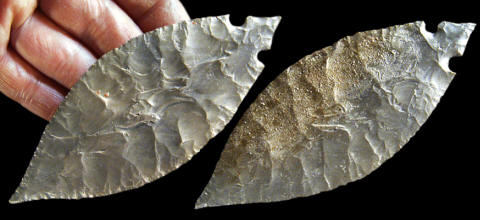|
FULTON
TURKEY TAIL
LATE ARCHAIC TO EARLY WOODLAND
ST. CLAIR COUNTY, ILLINOIS
PRIVATE COLLECTION
COPYRIGHT MARCH 31,
2012 PETER A. BOSTROM

CAST ILLUSTRATED
CAST
#A-15
FULTON TURKEY TAIL
LATE ARCHAIC TO EARLY WOODLAND
ST. CLAIR COUNTY, ILLINOIS
This is an exceptionally
well made example of a Fulton Turkey Tail. It's been published in six
different publications where its been described as being quintessential
(most perfect). It was found by Dean Burke in 1964 while surface
collecting in a field near Lebanon, Illinois in St. Clair County. Two or
three additional broken Fulton Turkey Tails are rumored to also have
been found at the same location.
This point is heavily patinated with a crusty surface on one side
and there are two or three small specks of red ochre that is still
preserved on the other side. This point is very thin for its size. It
measures 1/8 inch (3 mm) across the notched base. The notches are deep
and symmetrical with sharp points along the edges. The edges are also
very finely retouched with tiny pressure flakes. This point is made of
Cobden chert and it measures 4 3/4 inches (12.1 cm) long and 1 7/8
inches (4.8 cm) wide.
Fulton Turkey Tail points represent one type in the Turkey Tail
cluster. The other two types are the Harrison and Hebron points.
Fulton Turkey Tail points were named by Lewis Binford after Fulton
County, Illinois where many of them have been found. The shape of the
notched base was named for the shape of a dressed turkey's tail. These
points date to sometime during the Late Archaic and Early Woodland periods
between 3000 and 2500 years ago. They have been found in Kentucky,
Illinois, Indiana, Ohio, Michigan and New York.
|
